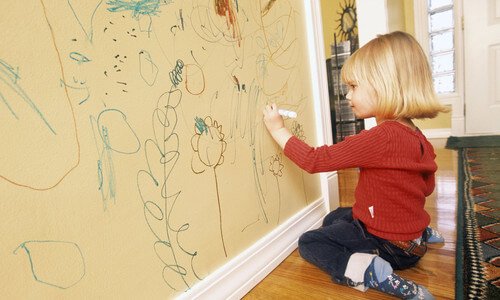Children's Drawings and Their Meaning

Children’s drawings usually take place after 18 months of age, which is when they begin to doodle as a means of expression. Little ones have fun drawing lines that may appear to be random. For them, however, they represent works of art as a product of their thoughts and ideas.
The importance of children scribbling lies in the activation of their imagination and fine motor skills from a young age. These are beneficial for children to develop their aptitudes and abilities. It also provides a fun way to express their emotions.
When children begin to shape their strokes on a sheet, they tend to be impulsive, unconnected, and uncontrolled.
They move their entire arm to be able to cover the space they have available. This activity amuses them and keeps them entertained. It also fosters the evolution of the first stages of artistic development.
As they grow, children’s skills strengthen and they acquire new abilities to improve their doodles.
They hold their colors better, and the lines are more defined. When the school routine begins, they improve what they learned at home with more techniques.
When children feel curiosity about picking up a color, don’t hesitate to give it to them and teach them to hold it correctly.
That way, they can begin to draw their first artistic strokes and jump into the world of drawing, which will surely result in unforgettable creations for you as a mother and for them.
Types of children’s drawings and their meaning
The initial phase of infant drawing or scribbling begins in the first few days when a child grabs a color and tries to draw on paper. This is when the process of motor and brain coordination starts.

Random scribbling
This is a motor function observed in children from approximately 20 months of age, also known as messy scribbling. It’s characterized by sketches or marks of pencils or colors that have no order or meaning. They can use one or several materials.
At this stage, children feel a motor discharge when drawing and they use their doodles to show their new language and way of communicating. In addition, they start recognizing the materials.
This phase is of utmost importance since it awakens their motor skills and attention to the environment. Consequently, all this will be reflected in the sheet.
Controlled scribbling
This is a perceptive level manifested by children from 20 to 30 months of age. From here, the tracing begins to take shape, children hold their pencils or colors better, and you can observe that they soften their movements when drawing.
The lines are longer and more defined, and they strive to fill the entire page with their graphic expressions.
On this level, the presence of kinesthetic learning is noticeable. That is, the ability to use their bodies to express ideas.
They observe the world around them more clearly in order to express it on the page. This is when they begin to draw circles, points, and cut lines.
“The importance of children drawing lies in the activation of imagination and fine motor skills from a young age.”
Named scribbling
Also known as a stage of representation, it ranges from 30–48 months of age. At this phase, children already have a better mastery of their motor skills and are able to explain what they draw.
Generally, they sketch what they observe or feel on the page, even though what they draw doesn’t resemble reality.
During this phase, children begin to choose the materials that will be used, what will be painted, and what color.
They’ll also center their drawings a little more and will feel proud of the possible reactions they get from adults who see their creations. That’s why it’s extremely important to encourage and congratulate them on their work.
The pre-schematic stage
This level ranges from 3–7 year-olds. In this instance, children represent the objects, people, and animals they see.
These drawings are a little more understandable, although the human figures are a circle for the head and two lines for the body. Many children also draw the fingers and hair.
When they start going to school, they’ll exploit their drawing potential in the classroom.
There, they’ll manifest ideas, share them with their peers, and have a better vision of the world of children. The resources for their compositions will vary and they’ll be able to develop their motor skills to the fullest.

The stages that follow are: the schematic stage, which takes place between the ages of 7 to 9, and the transitional stage that happens in ages from 9 to 14.
It’s in the latter that the perfection of the doodles occurs, which are now more like drawings. During these stages, children openly demonstrate their skills with sketches and combinations of colors.
In conclusion, children’s drawings are very important since the act of scribbling and doodling awakens cerebral motor skills. In the future, this will help them express themselves through varied artistic compositions, such as sketching and painting.
Children’s drawings usually take place after 18 months of age, which is when they begin to doodle as a means of expression. Little ones have fun drawing lines that may appear to be random. For them, however, they represent works of art as a product of their thoughts and ideas.
The importance of children scribbling lies in the activation of their imagination and fine motor skills from a young age. These are beneficial for children to develop their aptitudes and abilities. It also provides a fun way to express their emotions.
When children begin to shape their strokes on a sheet, they tend to be impulsive, unconnected, and uncontrolled.
They move their entire arm to be able to cover the space they have available. This activity amuses them and keeps them entertained. It also fosters the evolution of the first stages of artistic development.
As they grow, children’s skills strengthen and they acquire new abilities to improve their doodles.
They hold their colors better, and the lines are more defined. When the school routine begins, they improve what they learned at home with more techniques.
When children feel curiosity about picking up a color, don’t hesitate to give it to them and teach them to hold it correctly.
That way, they can begin to draw their first artistic strokes and jump into the world of drawing, which will surely result in unforgettable creations for you as a mother and for them.
Types of children’s drawings and their meaning
The initial phase of infant drawing or scribbling begins in the first few days when a child grabs a color and tries to draw on paper. This is when the process of motor and brain coordination starts.

Random scribbling
This is a motor function observed in children from approximately 20 months of age, also known as messy scribbling. It’s characterized by sketches or marks of pencils or colors that have no order or meaning. They can use one or several materials.
At this stage, children feel a motor discharge when drawing and they use their doodles to show their new language and way of communicating. In addition, they start recognizing the materials.
This phase is of utmost importance since it awakens their motor skills and attention to the environment. Consequently, all this will be reflected in the sheet.
Controlled scribbling
This is a perceptive level manifested by children from 20 to 30 months of age. From here, the tracing begins to take shape, children hold their pencils or colors better, and you can observe that they soften their movements when drawing.
The lines are longer and more defined, and they strive to fill the entire page with their graphic expressions.
On this level, the presence of kinesthetic learning is noticeable. That is, the ability to use their bodies to express ideas.
They observe the world around them more clearly in order to express it on the page. This is when they begin to draw circles, points, and cut lines.
“The importance of children drawing lies in the activation of imagination and fine motor skills from a young age.”
Named scribbling
Also known as a stage of representation, it ranges from 30–48 months of age. At this phase, children already have a better mastery of their motor skills and are able to explain what they draw.
Generally, they sketch what they observe or feel on the page, even though what they draw doesn’t resemble reality.
During this phase, children begin to choose the materials that will be used, what will be painted, and what color.
They’ll also center their drawings a little more and will feel proud of the possible reactions they get from adults who see their creations. That’s why it’s extremely important to encourage and congratulate them on their work.
The pre-schematic stage
This level ranges from 3–7 year-olds. In this instance, children represent the objects, people, and animals they see.
These drawings are a little more understandable, although the human figures are a circle for the head and two lines for the body. Many children also draw the fingers and hair.
When they start going to school, they’ll exploit their drawing potential in the classroom.
There, they’ll manifest ideas, share them with their peers, and have a better vision of the world of children. The resources for their compositions will vary and they’ll be able to develop their motor skills to the fullest.

The stages that follow are: the schematic stage, which takes place between the ages of 7 to 9, and the transitional stage that happens in ages from 9 to 14.
It’s in the latter that the perfection of the doodles occurs, which are now more like drawings. During these stages, children openly demonstrate their skills with sketches and combinations of colors.
In conclusion, children’s drawings are very important since the act of scribbling and doodling awakens cerebral motor skills. In the future, this will help them express themselves through varied artistic compositions, such as sketching and painting.
All cited sources were thoroughly reviewed by our team to ensure their quality, reliability, currency, and validity. The bibliography of this article was considered reliable and of academic or scientific accuracy.
- Berhard, N. (2006). Cómo interpretar los dibujos de los niños.
- Donzino, G. (2006). Interpretar dibujos. http://dspace.uces.edu.ar:8180/xmlui/handle/123456789/92
- Salsa, A. M., & Gariboldi, M. B. (2018). Experiencia con símbolos y comprensión de dibujos en niños pequeños de distintos contextos socioeconómicos. Avances en Psicología Latinoamericana, 36(1), 29-43. https://dialnet.unirioja.es/servlet/articulo?codigo=6231491
This text is provided for informational purposes only and does not replace consultation with a professional. If in doubt, consult your specialist.








